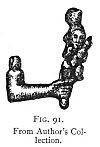
Click to enlarge
FIG. 90
A VERY short excursion in the field of comparative religions will show how one idea seems to have come from the far East in the early days of mankind, and to have taken root in the minds of all races who came westward. We have already referred to the faith which led the Magi to follow the star to Bethlehem. Throughout the East it was the primæval instinct that a child was to be born of a celestial mother, who should destroy the spirit of evil and be the saviour of mankind. Not only so, but the mother was to conceive and to bring him forth from her own inherent power. 366 With the triune male deity we find a single female associated. "Her names are innumerable, 'Mother of all the Gods,' The Lady, The Queen, Mulita, Bilta, Ishtar, or the bright, pure being. She is also Ri, Alitta, Elissa, Beltis, Ashtoreth, Astarte, Saraha or Sara, Nana, Asurah, Tanith. All these and more are Babylonish, but elsewhere she is Athor, Dea, Syria, Artemis, Aphrodite, Rhea, Demeter, Ceres, Diana, Minerva, Juno, Venus, Isis, Cybele, Ge, Hera. As Anaitis she is 'The Mother of the Child'; reproduced again as Isis and Horus, Devaki and Christna, Aurora and Memnon. Even in ancient Mexico the mother and child were worshipped. In modern times she survives as the Virgin Mary and her Son. There were Ishtar of Nineveh and Ishtar of Arbela, just as there are now Maria di Loretto and Marie de la Garde."
Indranee (and her child), consort of Indur from the cave of Indur Subha, are again one and the same person. Fig. 74 367 really represents Mary, whose name is synonymous with maternity, but not with ordinary maternity occurring on earth, inasmuch as throughout the ancient mythologies
the celestial mother was represented as a virgin 368--the same "woman who has replaced in Christendom the celestial virgin of Paganism."
The same author 369 records that in India, Christna, Chrishna, or Vishnu, is usually called "the saviour" or "preserver." "He, being a god, became incarnate in the flesh. As soon as he was born he was saluted by a chorus of angels or avators." "One of his names is 'the Good Shepherd.' Christna cured a leper, a woman poured on his head a box of ointment, and he cured her of disease. He washed the feet of Brahmins. Christna had a dreadful fight with the serpent Caluga. He astonished his tutor by his learning. He was crucified, went into hell, and afterwards into heaven. Christna and his mother are always represented as black. His statue in the temple at Mathura is black, and the temple is built in the form of a cross. As Vishnu he is painted with a Parthian coronet, when crucified. As Wittoba he has sometimes the stigmata in his hands, and sometimes in his feet, and one picture represents him with a round hole in his side: to his collar hangs a heart." 370
This account is so remarkable in its correspondence with our Gospel narrative that it seems almost incredible for it to be other than a paraphrase therefrom. Nevertheless, our author says "There is every reason to believe the legend to be more ancient than the Christian era." The various illustrations in other books fully support the foregoing. Chrishna is represented in Moor's Hindu Pantheon (p. 67) with a nimbus as shown in Fig. 72, while winged cherubs from above are sending down upon him rays of light, just as we are accustomed to see in pictures of the baptism of our Lord. He is also shown as crucified in precisely the same way, and with a crown of thorns and nimbus, just as we are accustomed to see in pictures of the Crucifixion. 371
Isis and Horus were distinctly associated with a fish, for we find her represented as bearing a fish on her head
 Click to enlarge FIG. 90 |
Further, we suggest that the celestial mother and child were not only objects of faith and worship, but representations
of them were certainly used as amulets. In support of this we point to Fig. 91, a bronze
 Click to enlarge FIG. 91. From Author's Collection |
226:366 Inman, Ancient Faiths, Vol. i. p. 98 et seq.
226:367 From Asiatic Researches, Vol. vi. p. 393. I am quite aware that Lieutenant Wilford is said to have been imposed upon by stories invented for him. Into that controversy I need not enter, and merely give his statements for what they are worth. Prof. Max Müller refers to this in an article in Nineteenth Century, October 1894.
227:368 Inman, op. cit. Vol. i. p. 253.
227:369 Ib. vol. i. p. 400.
227:370 Ib. vol. i. pp. 400-403.
227:371 Much information on this subject may be found in Hislop's Two Babylons, pp. 30-90. It is needless to say that we have no sympathy with p. 228 the purpose of this book nor with the spirit in which it is written. Moreover, judging from some of those we have endeavoured to verify, the references cannot be wholly relied on.
228:372 Inman, Ancient Faiths, vol. i. Frontispiece; also p. 520.
228:373 Payne Knight, Symbolical Language, p. 111.
228:374 Upon this subject see Mr. Gladstone's remarks in a paper on Heresy in the Nineteenth Century, August 1894, p. 174.